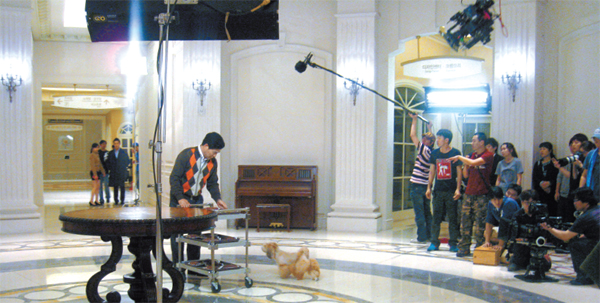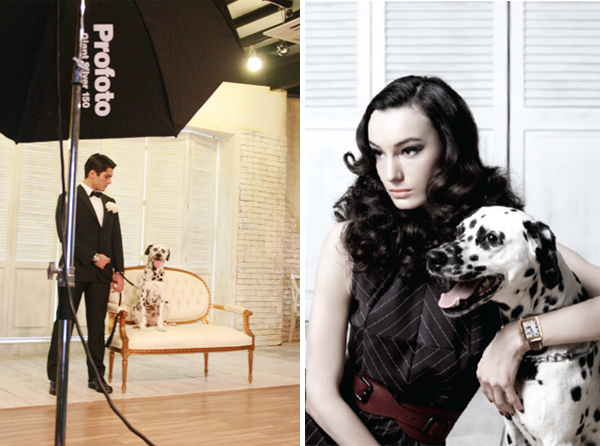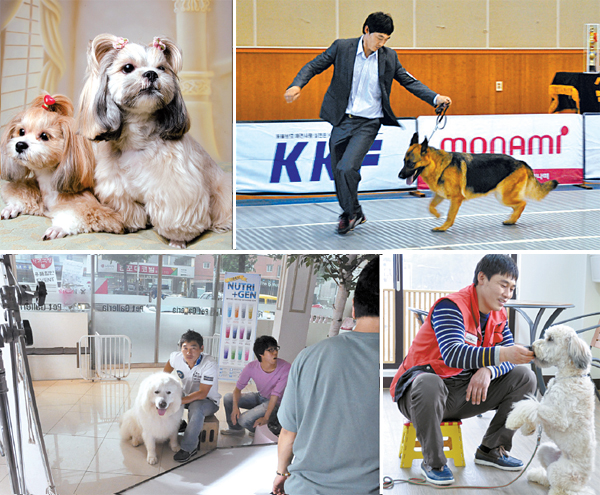Who’s best on shows? Camera-ready canines

Eunshil the Lhasa Apso was picked to appear in “The Tower” for her luxury appeal.Provided by Choi Yun-whoa
And it’s not hard to see why. The world is doggone mad about the four-legged creature that we call man’s best friend. You need not look very far to notice the little outfits, the strollers and the rise of organic pet food you see everywhere, often costing more than human grub.
Animal programs are a huge hit, and in line with this phenomenon, there is a demand for camera-ready canines.
Some dogs can earn hundreds of thousand won for an appearance, whether it is for fashion catalogues or TV shows.
But behind such super dogs are even more exceptional owners that invest their time, money and all that they have to the cause of making their dogs superstars, or close to it.
Korea JoongAng Daily sat down with two proud owners of model dogs as well as with dog trainer Lee Woong-yong to find out what it takes to set some dogs apart from the pack.

“She knows when she steps in front of the camera; she goes in and does all these poses when the shutter starts clicking,” says Marie’s owner, Pyo Eun-mi, who is one of many who find it amusing to see Marie tilt her head this way and that when on “work mode.”
Often the photographers and other models laugh at Marie because she’s “like a real model.” But the money she earns is no joke. Marie can fetch up to 600,000 won ($537) for a few hours in front of the lens.
“Appearance fees can range from 200,000 to 600,000 won,” says Pyo. “Let’s just say she earns her keep,” boasts the proud owner who has been training and driving her star dog around since she was 4 months old.
Since her pup days, Marie’s long legs and spotted fur have lent their glamour to high-end fashion brands and magazines.
“It all started when they were looking for a young Dalmatian in a hurry, so we went along to an audition and Marie got the job,” says Pyo, who found that because Marie was so good at her job that the calls kept coming.

And while Marie’s striking features no doubt played a part in her lucrative career, it’s not as a big a part as you’d expect.
“People think that looks play a huge part, but there is only so much you can do with a pretty dog if it won’t listen to its handler,” says Lee Woong-yong, the famed dog trainer you might recognize from various Korean variety shows.
A brother of Lee Woong-jong of “Animal Farm” fame, both Lees are well known in their field of taming unruly dogs.
With eight years of obedience training under his belt, Lee also trained police dogs and studied the delicate art of teaching dogs how to fetch Frisbees and be more agile.
The trainer, who divides his time between disciplining wayward dogs as well as making stars out of some, says that although it varies, most dogs have the potential for stardom as long as they have some basic commands down pat.

Clock wise, Eunshil (right) has starred in many commercials where the payment often came in the products she’s endorsed; Lee Woong-yong has appeared on various Korean variety shows; with his Great Pyrenees Sang-geun; Lee says that all it takes to launch a successful career for a canine is basic obedience.Provided by Lee
“Sang-geun earns about 400,000 to 800,000 won per week,” says Lee, who has often signed contracts on behalf of his pooch. “Or alternatively, per shoot, Sang-geun can pull in 600,000 to 700,000 won.” Lee does maintain though that he receives his fees from Sang-geun’s salary.
“Experts have to be on hand when filming takes place,” says Lee, adding it is the handlers who often work tirelessly behind the scenes of movies and TV shows to make sure that the dog does what the director wants.
Although not as much of a big shot as Sang-geun, another pooch that is no stranger to cameras is Eunshil, a 9-year old Lhasa Apso who recently made an appearance in the Korean blockbuster “Tower” as a spoilt little lapdog.
“We drove all night to get there and spent hours in the car, and it was freezing,” says Choi Yun-whoa, Eunshil’s owner who travelled to Paju in Namyangju in the middle of the winter to build her dog’s career.
Although being on stand-by, waiting in the car for hours in the blistering cold was a bit of an annoyance; Choi says it was something that she could brave for her beloved dog who was born for the role.
“They were looking for a dog that symbolized luxury and decided on a Lhasa Apso,” says Choi, who raises not just one, but three dogs of the exotic breed.
As a pioneer on the scene with her dog, Eunshil, Choi says that there is not really a standard or a guide for breaking into the doggy modeling scene.
On the set, she also adds that the way that animals are treated depends on the team.
“The actress holding Eunshil said that it was like carrying a calf,” says Choi who was a little taken aback by the comment.
“In most cases, the staff go out of their way to befriend the dogs,” says Choi, who believes that when dogs feel at home, it leads to better results on the screen.
Overall, she says that she was impressed with the way that the cast and crew of “The Tower” acted toward Eunshil, allowing her lots of time to run around during the day and even escorting her back to Seoul when Choi and the rest of her family had to return home, leaving Eunshil behind for a shoot.
Although the big screen is a new thing for the little dog, Eunshil has dabbled in advertising for some time, again starting at a young age like Marie.
“We never really had to buy dog products because we got them free from the jobs,” says Choi, adding that although making ends meet would be difficult as a full-time celebrity dog, there are other incentives.
Despite the freebies, a lot does go into raising a picture perfect dog.
In the case of Eunshil the Lhasa Apso, it means a lot of effort goes into keeping her coat shiny and camera-ready. No doubt the varied meals, frequent visits to the hair salon and regular walks all help in this department.
“We also have to watch her stress level before and during the shoot,” says Choi, who also takes time out to make healthy dog treats for Eunshil and her two sisters, Sena and Nana.
“Just like humans consume three meals a day, I try to give my dogs a varied diet and snacks throughout the day.” It’s not at all odd to see Eunshil take a bite of dried carrots, sweet potatoes or fresh fruit, meat and tofu as she goes about her day.
But as doting parents often do, Choi says that her dog really does have a star quality that not all dogs possess.
“She can sit still for hours and not snap at people,” Choi says, attributing this characteristic to the fact that Eunshil never once made a blooper.
And along with staying very still, Choi says Eunshil’s sociability helped.
“If the dog isn’t sociable, they might not do the tricks in front of the camera,” affirmed Lee. “Just because a dog can do cute tricks at home doesn’t mean that they’ll do it in front of strangers, or the camera.
“As well as basic obedience, there are specific skills like maintaining focus, looking at the camera, that is needed for dogs that want a career in TV,” says Lee. And some deception is involved too. “We used objects to lure dogs to look this way and that way behind the camera.”
And with all these tricks learned, Lee does confirm that like in real life when people try to break into the entertainment industry, timing plays a part, too.
Although there are some breeds like “shepherds and border collies,” that do possess the qualities that are fit for the limelight, time and market demand is of essence.
“It is the luck of the draw. Training centers get a lot of these casting calls and if one of the dogs there is doing well, and then they’d get cast,” says Lee.
And as the years have gone by, Marie’s owner does affirm that the demand for her pooch has waned a little bit. But in the meantime both Pyo and Choi say that they’ll keep up with their dogs’ activities, which brings smiles to not just the public, the viewers, but to them too.
By Carla Sunwoo [carlasunwoo@joongang.co.kr]










with the Korea JoongAng Daily
To write comments, please log in to one of the accounts.
Standards Board Policy (0/250자)